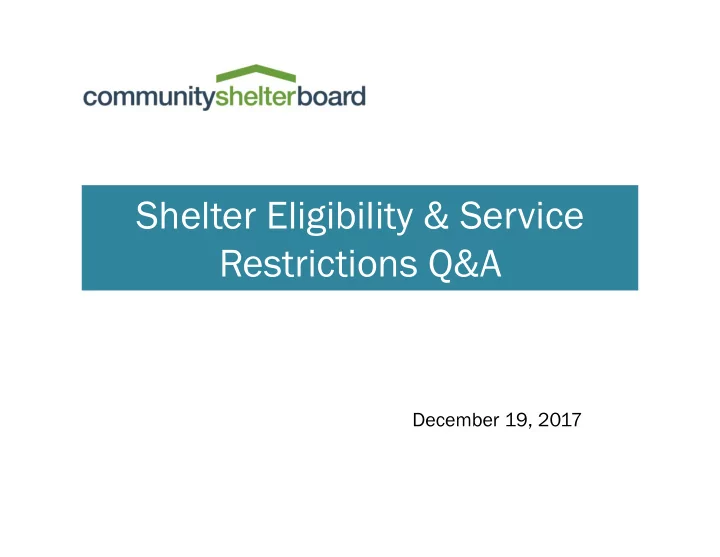

Shelter Eligibility & Service Restrictions Q&A December 19, 2017
Shelter Eligibility General Eligibility 18 years of age or older • Do not have physical custody of minor children • upon entry Currently in Franklin County • Currently not residing in an institution unless they • resided in an emergency shelter or place not meant for human habitation immediately before entering that institution Currently unsheltered tonight or will be • unsheltered tonight if not provided emergency shelter Shelter, re-housing and other critical needs are • best served by a single adult emergency shelter and are not more appropriately served by another resource or system of care Able to care for him/herself, including all • activities of daily living and medication administration Not a convicted sex offender subject to • community notification (An exception to this criterion for the NISRE Exit Program operated shelter is available during winter overflow periods)
Shelter Eligibility, continued Consent to basic shelter rules and • expectations, including actively working on an individualized housing stabilization plan in order to obtain permanent housing as quickly as possible and according to individual means and abilities; Behavior does not create safety or • health risks for self or others If previously stayed in shelter and • exited for safety, health or other involuntary exit reasons, then consent to behavior or other changes and conditions necessary to meet all emergency shelter eligibility criteria
Continued Eligibility An individual may stop meeting basic shelter eligibility requirements for various reasons. Below are a few examples: A previously unavailable or new safe • alternative housing option becomes available An individual has sufficient resources to • secure other housing, including temporary housing while they work to secure more permanent housing An individual demonstrates a need for a • higher level of care than available in emergency shelter and such care is readily available An individual is actively selling or • distributing illegal drugs on site An individual persistently violates basic • shelter rules, despite clearly communicated expectations and reasonable opportunities to comply An individual physically threatens or • assaults another person
Shelter to Shelter Transfers continued Shelter – To – Shelter Transfer Following shelter admission, shelter staff • may identify additional needs indicating another, more appropriate emergency shelter option should be explored. Shelter staff should review such cases during program level case conference meetings and with other shelter providers when it’s determined that a shelter transfer is needed to meet an individual’s needs. Shelter staff may also present such • cases for a system case conference in order to review and determine the most appropriate shelter option. All shelter-to-shelter transfers must be • recorded in CSP. All shelter-to-shelter transfers must be • coordinated with CPOA in order for CPOA to facilitate the shelter bed reservation.
Involuntary Exits Involuntary Exit • If a shelter resident is not longer eligible, the provider may initiate a shelter exit in accordance with a formal process established by the provider that recognizes the rights of individuals affected.
Involuntary Exits, continued Shelters should initiate an immediate shelter exit only for the following reasons: The individual’s housing options and/or resources have changes • sufficiently so that the individual no longer needs emergency shelter and can return to or secure safe, alterative housing, including stable temporary options while they work to secure more permanent housing. The welfare and needs of the individual cannot be met in the • shelter and another, more appropriate residential option is available. The safety of other individuals or staff in the shelter is • endangered. The health of other individuals or staff in the shelter would • otherwise be endangered.
Shelter Exits, continued Regardless of circumstances, unless an individual poses an immediate safety or health threat to others, or requires law enforcement or emergency medical care, emergency shelters should not exit individuals to unsheltered locations or other unsafe or inappropriate locations except in extreme situations and after all reasonable corrective steps have been exhausted.
Re-Entries In all cases, an individual who exits shelter involuntarily or voluntarily and then requests shelter again must be screened for eligibility per normal CPOA procedures and he or she may be placed on a waitlist.
Questions If you have any questions contact: Tom Albanese Associate Director, Community Shelter Board talbanese@csb.org 614-715-2536 Erin Maus System Manager, Community Shelter Board emaus@csb.org 614-715-2541
Recommend
More recommend